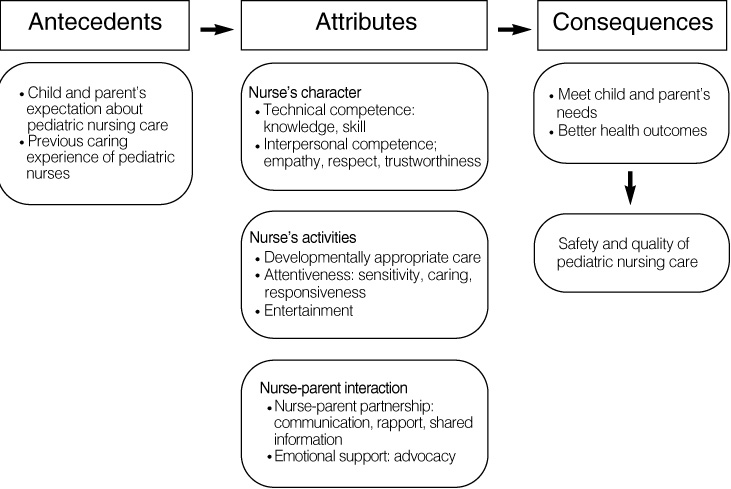J Korean Acad Nurs.
2010 Dec;40(6):757-764. 10.4040/jkan.2010.40.6.757.
Quality of Pediatric Nursing Care: Concept Analysis
- Affiliations
-
- 1College of Nursing, Seoul National University, Seoul, Korea. myb98@snu.ac.kr
- KMID: 999478
- DOI: http://doi.org/10.4040/jkan.2010.40.6.757
Abstract
- PURPOSE
This paper is a report of a concept analysis of 'quality of pediatric nursing care'.
METHODS
Rodgers's evolutionary method of concept analysis was used. Data were collected from published literature related to quality of pediatric nursing care.
RESULTS
Quality of pediatric nursing care was identified with three dimensions and seven attributes: 1) nurse's character: technical competence, interpersonal competence, 2) nurse's activities: developmentally appropriate care, attentiveness, entertainment, 3) nurse-parent interaction: nurse-parent partnership, emotional support. Antecedents of quality of pediatric nursing care were 'child and parent's expectation about pediatric nursing care', 'previous caring experience of pediatric nurses'. Consequences of quality of pediatric nursing care were 'meet child and parent's needs' and 'better health outcomes.'
CONCLUSION
'Quality of pediatric nursing care' is a core concept in pediatric nursing practice. Appropriate instruments to operationalize the concept need to be developed.
MeSH Terms
Figure
Cited by 1 articles
-
Effects of Anxiety, Parenting Efficacy, and Partnership With Nurses on the Caring Behaviors of Mothers of Hospitalized Children
Yu Jin Hong, Hyeon Ok Kim
J Korean Matern Child Health. 2024;28(3):111-121. doi: 10.21896/jkmch.2024.28.3.111.
Reference
-
1. Attree M. Towards a conceptual model of 'Quality Care'. International Journal of Nursing Studies. 1996. 33:13–28.2. Bae SH, Shin SR. Development of a quality evaluation tool for aneurysmal subarachnoid hemorrhage patient care. Journal of Korean Academy of Adult Nursing. 2003. 15:628–638.3. Betz CL, Cowell JM, Craft-Rosenberg MJ, Krajicek MJ, Lobo ML. Health care quality and outcome guidelines for nursing of children and families: Implications for pediatric nurse practitioner practice, research, and policy. Journal of Pediatric Health Care. 2007. 21:64–66.4. Chi SA. Outcome indicator of quality nursing care. Journal of Korean Academy of Nursing Administration. 1997. 3:107–118.5. Craft-Rosenberg M, Krajicek MJ, Shin DS. Report of the american academy of nursing child- family expert panel: Identification of quality and outcome indicators for maternal child nursing. Nursing Outlook. 2002. 50:57–60.6. Forrest CB. Outcomes research on children, adolescents, and their families: Directions for future inquiry. Medical Care. 2004. 42:III19–III23.7. Forrest CB, Simpson L, Clancy C. Child health services research: Challenges and opportunities. Journal of the American Medical Association. 1997. 277:1787–1793.8. Gunther M, Alligood MR. A discipline-specific determination of high quality nursing care. Journal of Advanced Nursing. 2002. 38:353–359.9. Institute of Medicine, Committee on Quality Health Care in America. Crossing the quality chasm: A new health system for the 21st century. 2001. Washington, DC: The National Academies Press.10. Jun M, Peterson RT, Zsidisin GA. The identification and measurement of quality dimensions in health care: Focus group interview results. Health Care Management Review. 1998. 23:81–96.11. Kim NY, Jang KS, Ryu SA, Kim YM. The analysis of nursing research in Korea in relation to the evaluation of quality of nursing. Journal of Korean Academy of Nursing Administration. 2003. 9:337–352.12. Kwon SB, Chi SA, Back KS, Yu SO, Ju SN, Kim BJ, et al. Content analysis of quality nursing care perceived by nurses. Journal of Korean Academy of Nursing. 2001. 31:380–390.13. Lacey SR, Klaus SF, Smith JB, Cox KS, Dunton NE. Developing measures of pediatric nursing quality. Journal of Nursing Care Quality. 2006. 21:210–220.14. Larrabee JH. Emerging model of quality. Journal of Nursing Scholarship. 1996. 28:353–358.15. Lee P. What does partnership in care mean for children's nurses? Journal of Clinical Nursing. 2007. 16:518–526.16. Lenburg CB, Klein C, Abdur-Rahman V, Spencer T, Boyer S. The COPA model: A comprehensive framework designed to promote quality care and competence for patient safety. Nursing Education Perspectives. 2009. 30:312–317.17. Lindeke L, Nakai M, Johnson L. Capturing children's voices for quality improvement. MCN. The American Journal of Maternal Child Nursing. 2006. 31:290–295.18. Macphee M. High-quality health care for children: What can we do? Journal of Pediatric Nursing. 2007. 22:1–3.19. Miles MS. Support for parents during a child's hospitalization. American Journal of Nursing. 2003. 103:62–64.20. Parish SG. Quality vs. quantity: Which type of nursing do you practice? Journal of Practical Nursing. 1986. 36:30–31.21. Pelander T, Lehtonen K, Leino-Kilpi H. Children in the hospital: Elements of quality in drawings. Journal of Pediatric Nursing. 2007. 22:333–341.22. Pelander T, Leino-Kilpi H, Katajisto J. Quality of pediatric nursing care in Finland: Children's perspective. Journal of Nursing Care Quality. 2007. 22:185–194.23. Pelander T, Leino-Kilpi H, Katajisto J. The quality of paediatric nursing care: Developing the child care quality at hospital instrument for children. Journal of Advanced Nursing. 2009. 65:443–453.24. Price PJ. Parents' perceptions of the meaning of quality nursing care. Advances in Nursing Science. 1993. 16:33–41.25. Rodgers BL. Rodgers BL, Knafl KA, editors. Concept analysis: An evolutionary view. Concept Development in Nursing: Foundations, Techniques, and Applications. 2000. 2nd Ed. Philadelphia: W. B. Saunders Company;77–102.26. Sarajärvi A, Haapamäki ML, Paavilainen E. Emotional and informational support for families during their child's illness. International Nursing Review. 2006. 53:205–210.27. Schnorr E. Quality indicator and outcomes -so what. Academy of Medical Surgical Nurses. 1999. 8:4–5.28. Taylor AG, Hudson K, Keeling A. Quality nursing care: The consumer's perspective revisited. Journal of Nursing Quality Assurance. 1991. 5:23–31.29. Walker LO, Avant KC. Strategies for Theory Construction in Nursing. 2005. 4th eds. Upper Saddle River, NJ: Pearson Prentice hall.30. Ygge BM, Arnetz JE. A study of non-response in a questionnaire survey of parents' views of paediatric care. Journal of Nursing Management. 2004. 12:5–12.


